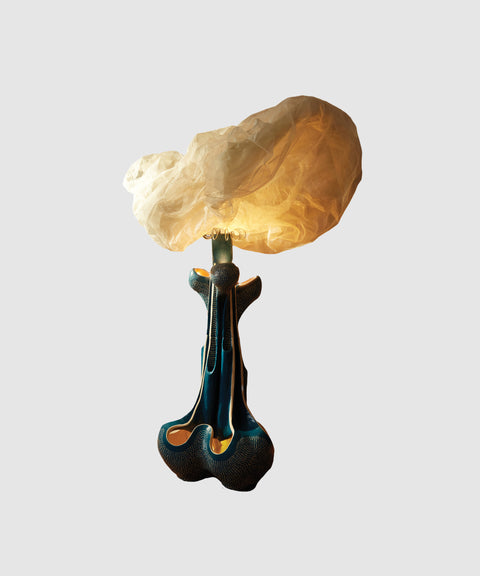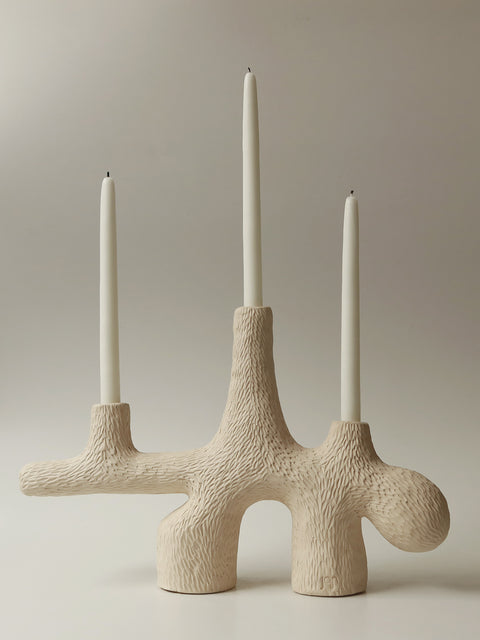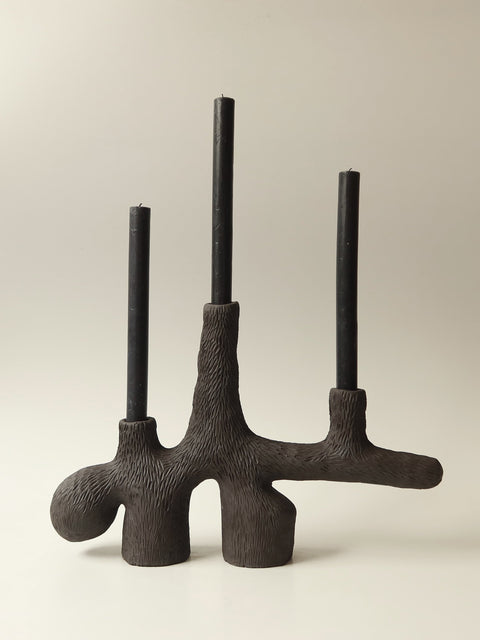Jan Ernst is a multidisciplinary creative specializing in functional art and spatial design using clay as his main medium. His organic designs stem from his abstract understanding of form and space influenced by his background in architecture, his connection with the natural world and his South African heritage.

What is the message or narrative that you wish to tell the public through your art? Has it evolved through time?
When I started doing ceramics the message in my head wasn’t very clear, I felt quite drawn to creating textural objects that spoke of the South African landscape. As a child we moved around a lot, so I was exposed to all these beautiful places around the country, and it was kind of easy to interpret these landscapes into sculptural pieces. Then, more recently I made a conscious effort to start telling stories that are of nature and of humans so that the work becomes more relatable to human beings. So, for instance, with the “Time Lapse” collection it is all about time, and an awareness of time, how humans perceive time – but how is that reflected in nature? And that goes back to looking at trees. It is about finding a common thread that is of nature and of human. A piece that I’m working on is called “Convergence” and it is about two forces coming from two different places and then meeting and creating energy. A world of possibility. If we translate that into nature, I almost see it as two rivers coming together, merging, and creating something beautiful. Or it could be two human beings coming together. I’m trying to find that duality and common space between man and nature.

Talking about the Time Lapse series featuring the “Daydream Floor Light” and your unique approach to shape, texture and material, which artistic techniques and materials do you prefer to work with?
My main medium is ceramics – or clay - and I guess it will always be the focus and what people know me for. But when we start to create a new piece there are always various avenues that we explore before we get to the final thing that might end up being clay. Because of my architectural background I look a lot at making little models and that could be anything – from plasters to shells glued together. Other times it is more about very big drawings. My process isn’t very linear, and each project calls for something different. Now I’m working with the most ancient rug company in Egypt, which has asked me to design something with them and I had no idea how to approach it. For some odd reason I found myself thinking of linocuts. The materials are also selected in terms of which object is being created.So, in the end, each project calls for specific materials that allow to communicate the message of the piece.

Can you explain the different phases of your creation process? Which are the difficulties linked to it - if there are any?
The process is quite different for each project. A typical process would start from a brief, either with a client, or a gallery, or just a team brief. There is a lot of back and forth. Using the “Daydream Floor Light” as an example, I was firstly asked to design a floor light that was inspired by a tree, and I wasn’t sure of where to start. It made sense to me to go walk around the trees, so I went in the forest and started looking critically. It is also important to have a strong seed idea, to know what the driving force behind it is. So, I started thinking about it, and trees for me have a strong architectural basis. It took me back to childhood, when I spent a lot of time outdoors and I loved climbing tress because they felt like safe spaces that would envelop me, hold me, and catch me. They were a place of escaping and daydreaming. After that, I must think of how to translate it into form. I spent a lot of time understanding the lamp shade and one of the requirements was to not see the light fittings inside of the shade.
That was a great constrain to guide me, because I knew that the shade should have been enveloping, without bulbs to be seen and it then made sense to use a steel mesh that could give structure and airiness. And finally, the base came to me quite suddenly – actually, the blue tree that you can find on OWN is the first piece we created. Sometimes a lot of drawing is involved, most of the times while building I enjoy documenting with photographs the many steps of the process, particularly in black and white. I also use these pictures to understand better the piece, they are part of the process.
Most of the time the various phases of the process overlap, so it happens that while we build, we also keep on drawing.
Bespoke Artwork



Which objects hold the most meaning for you, and do you collect?
Because of what I do and because of my moving around quite much, I learned that the stuff that I need or that I’m fond of might be one or two pieces that I’ve made, but I don’t have a lot of things that I feel particularly strong about.
I recently started doing trade exchange with some South-African painters and those pieces are very specific. So yeah, I don’t have a specific object I feel particularly strong about, of course I appreciate beautiful things, but I prefer to have something small and meaningful than a grand chandelier or whatever.

What does your studio look like? And what would your dream studio look like?
Before we moved into the studio, in my mind I always saw myself as a nomad that would never root anywhere, moving freely around the world. That idea changed a lot ever since I created this studio which is very dear to my heart. When we first moved here it was an empty shell. Me and my team built everything with our own hands, I designed the space, we basically designed and built everything in here with blood sweat and tears. This space has a beautiful energy. It attracted so many beautiful people also from the design industry but most importantly people that are dear to my heart. I held beautiful and meaningful conversations in this space, so I suppose that a dream studio wouldn’t be too far off from this one. Of course, I would love to have more space as the pieces become bigger and bigger, and I would love more natural light and a courtyard so to breathe a little bit outside. But I love my current space.
Jan Ernst's Studio





To create design objects and sculptures means to have a vision on inhabiting a space. What is your aesthetic, your philosophy?
I used to have this friend that moved from Johannesburg to Cape Town and for a few years he rented an apartment and nothing in there was his own. He never even added a picture of him or of his family. It was this weird limbo space that was his but that had nothing of his or that spoke about him as a human being. Like I said, I don’t own much stuff, but I do think that living with objects and living with design and art is an extremely personal thing. It reflects something about you. When I design these objects, this is something I really keep in mind. And of course, there is also the physical aspect: what does this thing look like in a home? How do people move around it? How to people engage with it? For example, when I created the “Womb Lights”, it was a considerate approach of where these pieces would go. In terms of a philosophy all the pieces are as minimal as I can get them, very primal but stripped of all the little things that could make them “impure” – the texture for example, is applied afterwards, it is not a result of the material.

Which amongst your projects or artworks represent you the most?
If I had to pick one, I would say maybe the “Daydream Tree” is one of my proudest moments. In terms of complexity, building it was hectic, difficult, and physically heavy, with lots of technical things to consider. It was also going to PAD London, so it was destined to a very prestigious place. The mirror I recently completed for a house in Cape Town is also significant because it is the first commissioned mirror in South Africa, and it was particularly interesting because the client wanted a human story tied to it, so I spent time also understanding what his story was. And lastly, this new bronze candelabra I’m currently working on is very special as it is something I’ve been wanting to work on for a long time and I’m particularly proud of the result.
What is the most memorable trip you’ve taken? Does traveling impact your creative process?
Apart from being necessary because it feeds your soul as a human being, travelling is super important to me as a creative. For example, my recent trip to Paris was very important, not only for the PAD but also for exposing me to experiences such as the Brancusi Museum, to see what people in the past did. If we think about natural kind of places, I’m going to Armenia in two and half weeks to host a workshop there and there will be trips to insane national parks with canyons, beautiful colours and rock formations. Another trip that particularly stood up for me was Turkey. It was incredible to think that nature created such things, that what I was seeing wasn’t a man-made thing. And finally, my time in Spain, where I took my master’s in architecture. I only now realise the insane amount of influence Gaudì had on the way I understand form. I travelled to interesting places like Pakistan, which was fabulous to see, and Kenya too. It is expensive to travel from South Africa but if you can and have the resources, it is incredible to not just see but also to get out of your comfort zone and feeling unnerved.

The best gift you’ve ever received?
I’m going to answer this question in a different way. I couldn’t think of one thing. I also find far more joy in giving rather than in receiving gifts. If someone gave me something sentimental or meaningful, even if it’s a little bead, it would be far more significant. But I love giving, and I love giving freely, even if it’s just to light up someone’s day. I’m far more inclined to give gifts, than to receive them.

An artwork or exhibition that took your breath away?
It would be the Brancusi exhibition I was telling you about. It was so beautiful, and of course I had seen his pieces before but looking at it with a more critical approach you can see a lot of things. I was terribly disappointed to not see the Jean Arp’s exhibition. Both sculptors’ work influences or inspires my work. I suppose Arp’s is closer to mine in terms of shape and form, but Brancusi’s marriage of more geometric and organic is particularly interesting, and you can stand there and just feel the power and the significance of what a privilege it is and how relevant it still is today.


















































